Seared, soaked and socially distant, Australia has copped the full onslaught of disruptive events in 2020, and calls for an integrated response to Covid-19 recovery and climate change seem to be gaining only partial traction with the Federal Government. Accenture’s annual survey comes at the combined challenge from a different perspective — the unpreparedness of global energy utilities to weather a forecast of continuing extremes.
A survey of 206 executives of electricity executives in 28 countries, conducted online from November 2019 to January 2020, has found that 95% of respondents believe that climate change due to greenhouse gas emissions has been a contributing factor to the increases in extreme weather events their utilities have experienced over the past 10 years.
Only a quarter of the same cohort report that their businesses are very well prepared to deal with the impacts of unprecedented levels of disruption caused by changing weather patterns, while 92% said they expect the incidence of severe weather to increase in the coming 10 years.
“Greater system flexibility, delivered through digital and emerging technologies will be critical to optimising grid resilience in a cost-effective and timely manner,” said Stephanie Jamison, Accenture’s UK-based Global Utilities Leader, in a statement released alongside the company’s research.
She cites “active management of available network redundancy, distributed generation and energy storage” as a means to “maintain power delivery during severe weather events, and speed service restoration after network failures.”
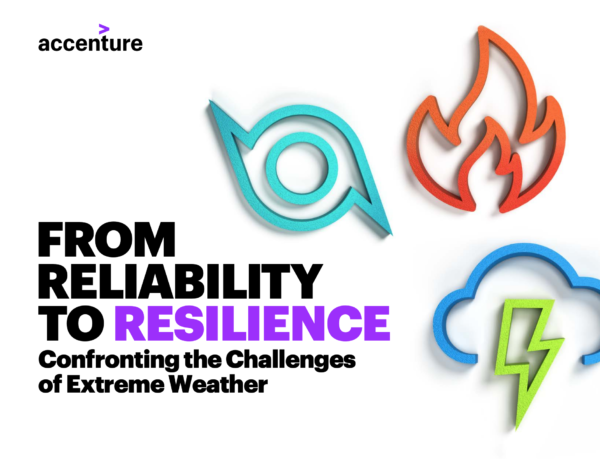
Image: Accenture
Australia on the road to resilience
In Australia, many initiatives are underway to demonstrate ways to embed resiliency in our power systems. For example:
- The Australian Energy Market Operator (AEMO) is investigating the opportunities for networked distributed energy resources, presented by the country’s deep penetration of rooftop solar.
- The Mike Cannon-Brookes-sponsored Resilient Energy Collective is installing prefab solar systems and Tesla batteries at 100 bushfire stricken community sites still limping without power after summer’s cataclysmic bushfires — an initiative that is expected to act as a pilot project for future disaster response.
- And Western Australia’s state-owned utility Horizon Power is enabling edge-of-grid properties with standalone hybrid power systems, eliminating their reliance on bushfire-vulnerable poles and wires.
The Accenture report describes extreme weather as “the new reality”, which utilities need to consider in the light of changes to the grid required to accommodate greater penetration of renewables and reduce emissions; the need to effectively provision essential services — whatever the weather and in the face of increased cybersecurity risks; and the effect of more frequent severe weather events on utilities’ ability to secure insurance for their infrastructure.
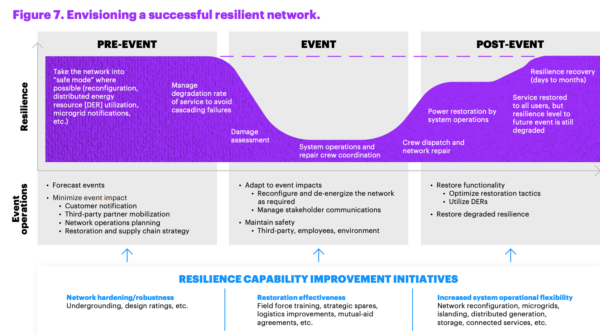
Image: Accenture
Just add Covid
The new reality must also now be considered in the context of other disruptive events such as the Covid-19 pandemic, which, says the report, “could cause yet-to-be-determined long-term disruption for utilities, the economy and society at large”.
Accenture finds that most resilience efforts made on behalf of utilities to date have been “more tactical than strategic, and have thus succeeded only at enhancing reliability.”
Despite confidence in Australian electricity reliability, cracks are beginning to show in management of the system from an overall resiliency perspective, especially given the financial hardship experienced by electricity consumers during restrictions on working imposed by Covid-19.
Last week, the Australian Energy Market Commission (AEMC), recognised that consumers applying to gen-tailers and retailers for payment plans that would enable them to delay paying their electricity bills in full, was resulting in financial pressure on utilities that could result in their being unable to pay network fees which comprise up to 80% of their own costs.
While not yet a threat to reliability of power supply, this situation illustrates the lack of resilience of utilities in the face of multiple challenges. The AEMC is urgently considering a rule change that will allow utilities to defer their network costs, to avert the prospect of them collapsing under the requirement to continue to serve “hardship” customers during Covid-19.
At the same time, the AEMC announced plans to support the installation of off-grid energy systems in remote and extreme-weather or bushfire-prone regions of the National Electricity Market, similar to the rollout of standalone hybrid systems by Horizon Power in Western Australia. Such a move would reduce costs of servicing these communities with poles and wires, and improve their prospects of maintain power supply when bushfires or violent weather threaten power lines..
“Standalone systems give electricity networks more options,” said AEMC chair John Pierce, who explained that even though the numbers of remote electricity consumers is relatively low, the disproportionately high financial impost of providing them with electricity will help service providers significantly reduce their costs of operating.
A high-level to-do list for utilities
Accenture’s list of actions towards achieving greater resilience of power supply in support of ongoing reliability includes:
- Confirming corporate-level responsibility for developing and articulating a resilience strategy and embedding it in the company’s governance structure and processes.
- Instigating an ongoing program to build dialogue with external stakeholders to inform the resilience strategy.
- Reviewing data and modelling capabilities in light of the resilience requirements, such as local weather tracking and asset-fragility analysis.
In Australia such actions have begun to take shape at a transmission level, albeit at a snail’s pace. Increasing the number of interconnectors between states, for example, will confer resilience in the face of extreme storms which in the past have knocked out a sole critical flow of energy between South Australia and the NEM.
Home-battery programs to support existing residential rooftop solar installations, and solar/battery programs, and the rise of virtual power plants can increase the potential for grid independence of residential areas in times of weather-induced outages, but such resilience opportunities have yet to be implemented at scale, and integrated into the NEM and utility plans.
V2G and shared-battery applications in support of resilience
The Accenture report offers a couple of interesting case studies. In the area of Emerging resilience solutions, it describes how Nissan and EDF Energy are using customer EVs to provide services to the grid: “The utility is currently offering vehicle-to-grid (V2G) programs to business customers in the UK, covering cars (Nissan Leaf) and small commercial vans (Nissan e-NV200).” The commercial systems, enabled by bidirectional chargers, can participate in local electricity markets.
Although this V2G model is not yet used to provide resilience, the potential exists to co-opt such systems at times when the grid is compromised by disruptive events.
Australian industry players are investigating every avenue for incentivising and viably deploying large-scale batteries — to support both the capabilities of the grid and their own objectives; Accenture cites the example of metropolitan Nice, in France, which has “explored automatic islanding based on a storage battery system to provide security of supply and resilience … in areas where power supply is critical.”
The Nice battery was shared by Enedis, a distribution service operator, and Engie, a market player: During islanding operations Enedis remotely steered the battery from a regional control room; when the battery was not required for islanding, it was operated by Engie, which monetised it “on several value pockets” to drive profit on the battery investment. In islanded mode, such as might be required during high-impact extreme weather events, Enedis succeeded in managing the distribution grid without power cuts to its customers.
Accenture concludes that, “The challenge of becoming more resilient may be formidable, but it is also unavoidable.”
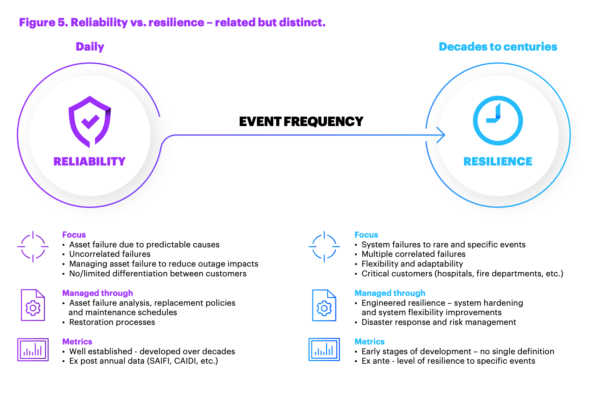
Image: Accenture
Ninety per cent of utility executives responding to its survey said extreme weather events would increase the potential risk to the ongoing financial viability of the network business.
“In the long term,” says Charlie Richardson, Utilities Lead for Accenture in Australia, “utilities can promote greater resilience by linking the benefits of major investments to grid-modernisation strategies, to convince policymakers, customers and other stakeholders of those benefits.”
This content is protected by copyright and may not be reused. If you want to cooperate with us and would like to reuse some of our content, please contact: editors@pv-magazine.com.
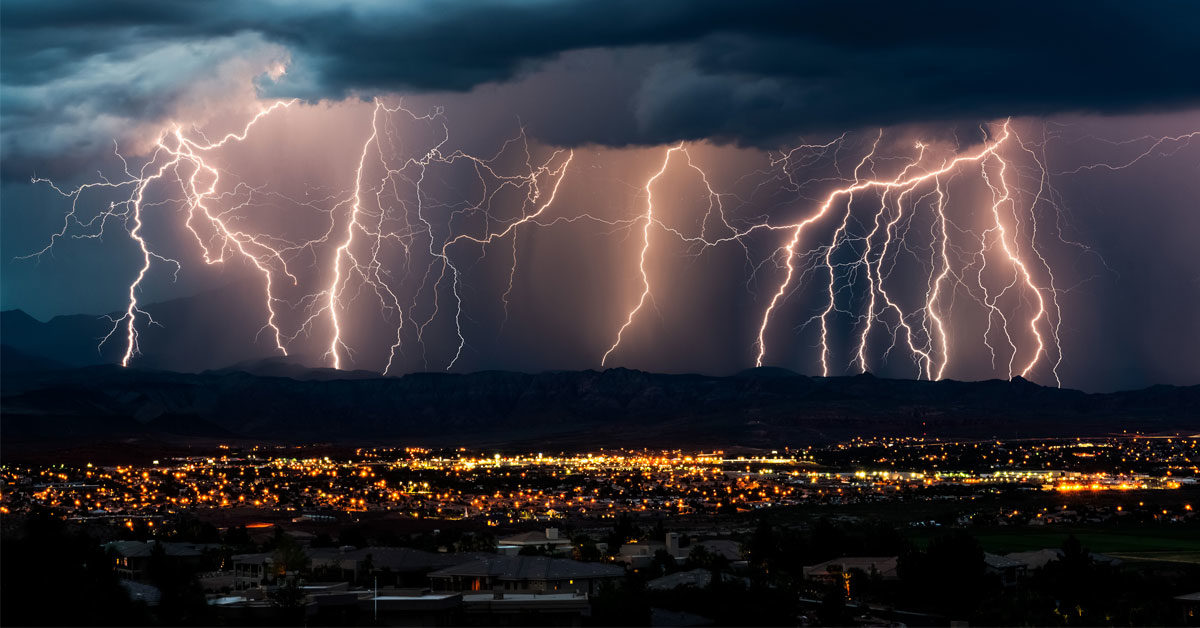




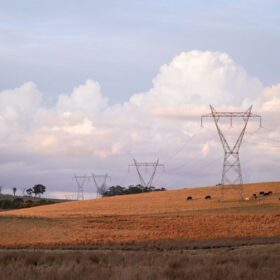
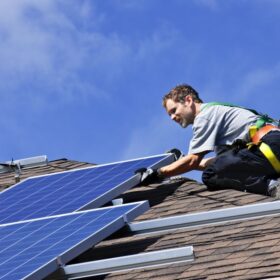
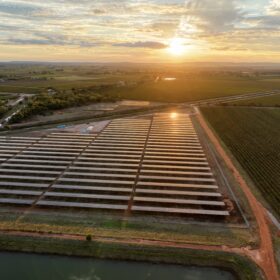
“A survey of 206 executives of electricity executives in 28 countries, conducted online from November 2019 to January 2020, has found that 95% of respondents believe that climate change due to greenhouse gas emissions has been a contributing factor to the increases in extreme weather events their utilities have experienced over the past 10 years.”
Finally a “consensus” on climate change, but a dilatory response to what is being witnessed. Because these well paid CEOs have been sitting on their thumbs for 10 years, puts grid hardening projects 10 years behind. Instead of paying for upgrades to harden the grids, in 2010 dollars, now these entities will have to borrow money or float and service bonds in 2020 dollars and beyond.
” The Nice battery was shared by Enedis, a distribution service operator, and Engie, a market player: During islanding operations Enedis remotely steered the battery from a regional control room; when the battery was not required for islanding, it was operated by Engie, which monetised it “on several value pockets” to drive profit on the battery investment. In islanded mode, such as might be required during high-impact extreme weather events, Enedis succeeded in managing the distribution grid without power cuts to its customers.”
Interesting, the utility industry is (finally) catching on to what large scale energy storage really means. You can use an energy storage system for islanding, you could use the system for stacked grid services, but the revenues advantages actually seem to point to an asset with a 5 year payback period and 10 warranty. It’s going to take another 15 years of operations of these early adopted sites to see just how long one can operate them, how many revenue streams can one “create” with operations changes and just how long can one “run this dog” before it can’t ‘hunt’ anymore? On this particular site, it may not be as effective or reliable as a FCAS system after 10 years online, but could still be useful as an islanding system during storm events for many years to come. The decision flow chart there is, after 10 years of multiple operations should we continue to run the site in reduced capacity for (islanding) or replace the battery packs and refurbish the inverters and start another 10 year cycle? After someone gets to actually DO a 10 year plus cycle, the industry will not know for sure. It seems like the TESLA big battery will be the first test case, by 2027 one should have a feel for how much life is left in this battery installation.